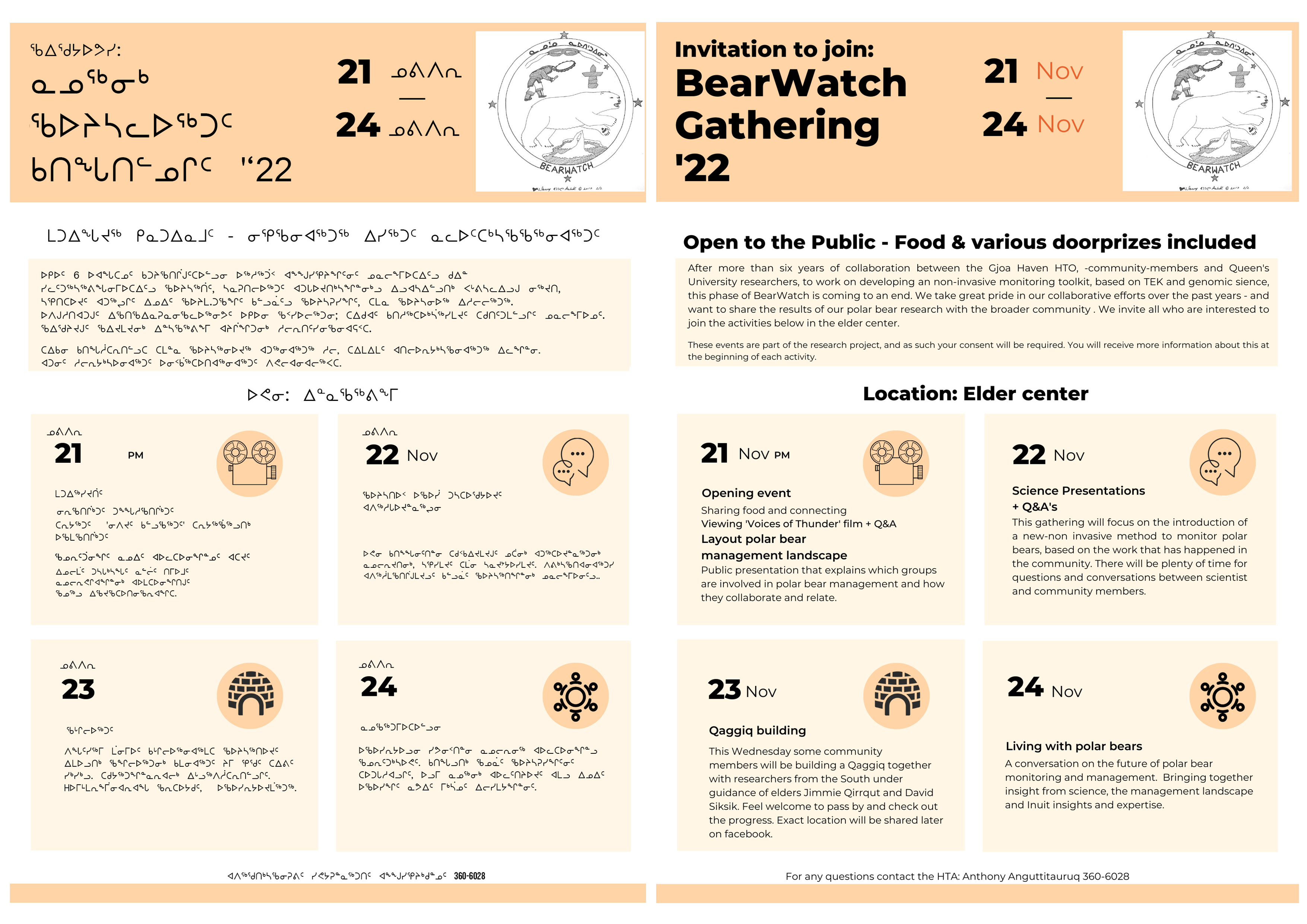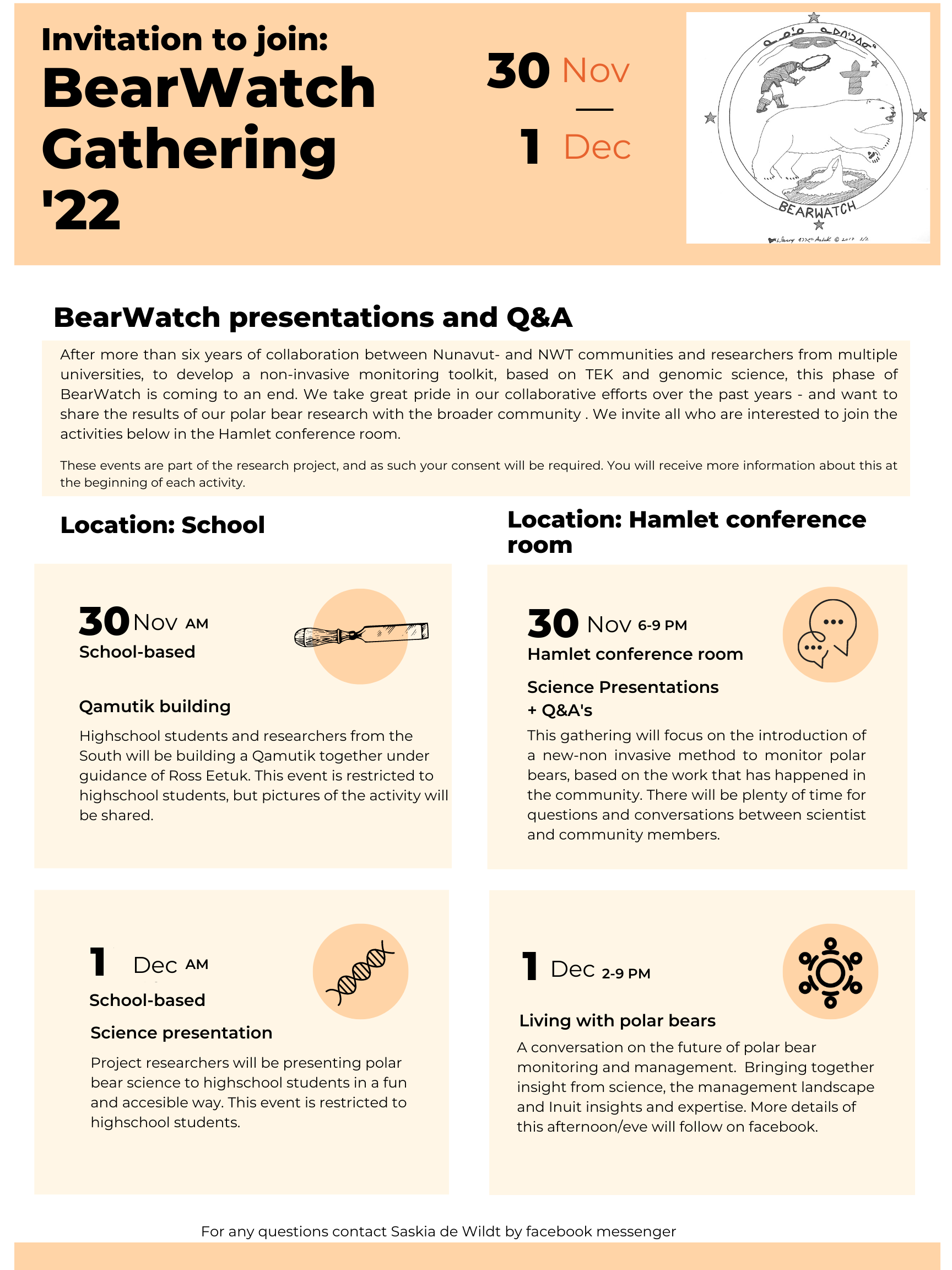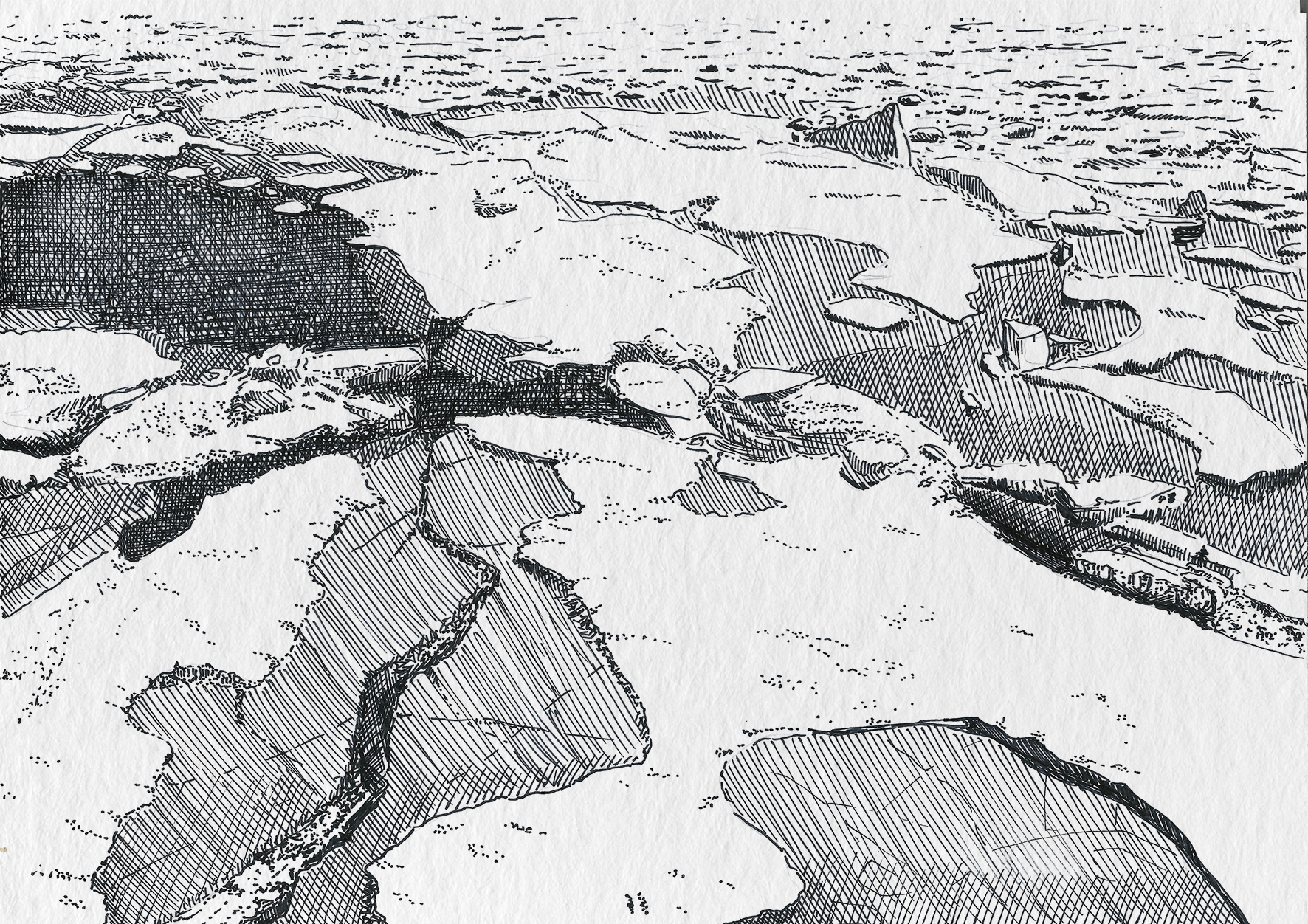Fall 2022 Gjoa Haven: Difference between revisions
| Line 36: | Line 36: | ||
Both workshops were evaluated in different ways. | Both workshops were evaluated in different ways. | ||
In Coral Harbour, the funders were not present for the workshop, nor was one of our PI's and one of the project managers that had been present in Gjoa Haven. Our local co-PI was also unavailable for the final gathering. The conditions had furthermore not been in place for us to organize a pre-workshop with community members during the earlier visit in the community. | |||
Instead, we opted to hold a smaller pre-workshop meeting with the two BearWatch PI's, the former government biologist of NWT and I, as well as a meeting with a local interpretor, who we had hired to work with us in Coral Harbour. | |||
This pre-workshop was prefaced on "lessons-learnt" from the Gjoa Haven Gathering, without presuming that the terms of engagement drafted in the previous community would apply in Coral Harbour as well. During this pre-workshop meeting, and with the input of the interpretor, we agreed upon certain processes to be applied in the Coral Harbour gathering. Subsequently we evaluated these processes in a post-workshop evaluation with the same group of people. | |||
In February 2023, the next year, I conducted eight follow-up individual interviews with the Southern researchers, government biologist, funders of the BearWatch project and the interpretor from Gjoa Haven to discuss their experiences of the workshops, two months after it had taken place. | In February 2023, the next year, I conducted eight follow-up individual interviews with the Southern researchers, government biologist, funders of the BearWatch project and the interpretor from Gjoa Haven to discuss their experiences of the workshops, two months after it had taken place. | ||
Revision as of 19:31, 24 February 2025
After losing a week in travel delays, there is a lot of preparation left to do for the final workshop in Gjoa Haven- starting with the organization of a "special meeting" with the HTA to finetune the agenda, invitees, and logistical set-up of the meeting.
Luckily, it is much easier to set up such meetings in Gjoa Haven, than it was in Coral Harbour. Due to the much wider relational network here, it was more clear how to engage in collective dialogue and logistically produce a gathering that meets community desires.
Cut 2: Gjoa Haven (Pre-)Gathering
Winter 2022 Final Workshops
In Gjoa Haven we organized a three-day gathering, that was preceded by a two-day pre-workshop that fed into the design of the gathering. The final gathering was kicked-off the evening before with a community feast and the screening of the three movies that were co-created with the community and the HTA. Following these screenings Marsha Branigan, the recently retired government-biologist of the North-western Territories, presented on the the governance structure of polar bears as to set an informative background for the upcoming three days.

The first day consisted of presentations from the BearWatch scientists.
The second day was designed to be a collective exercise, providing an opening to encounter each other in renewed ways and gain insights into what knowledge conciliation beyond a data-driven approach could look like.
The third day consisted of a collective discussion that included a community-panel on "living with polar bears", bringing together community insights, science and management to set a direction for future work.
Although in Coral Harbour we did not manage to organize a pre-workshop, we did combine our two-days workshop with multiple school activities - including a sponsored lunch, a science bingo, and the collective building of a Qamutiq, that was donated to the school after.

BW Final Reporting
Both workshops were evaluated in different ways.
In Coral Harbour, the funders were not present for the workshop, nor was one of our PI's and one of the project managers that had been present in Gjoa Haven. Our local co-PI was also unavailable for the final gathering. The conditions had furthermore not been in place for us to organize a pre-workshop with community members during the earlier visit in the community.
Instead, we opted to hold a smaller pre-workshop meeting with the two BearWatch PI's, the former government biologist of NWT and I, as well as a meeting with a local interpretor, who we had hired to work with us in Coral Harbour.
This pre-workshop was prefaced on "lessons-learnt" from the Gjoa Haven Gathering, without presuming that the terms of engagement drafted in the previous community would apply in Coral Harbour as well. During this pre-workshop meeting, and with the input of the interpretor, we agreed upon certain processes to be applied in the Coral Harbour gathering. Subsequently we evaluated these processes in a post-workshop evaluation with the same group of people.
In February 2023, the next year, I conducted eight follow-up individual interviews with the Southern researchers, government biologist, funders of the BearWatch project and the interpretor from Gjoa Haven to discuss their experiences of the workshops, two months after it had taken place.
Explore this landmark insight, that became a defining feature of this knowledge-land-scape.
Or keep going to reach the end of this cut.Another Point of Beginning
You have reached "Another Point of Beginning". These are not conclusive endings to my research, but rather perform at the cusp of emergence: They are a story so-far. Some of these points mark the end of funding cycles or project activities. Or they mark the limitations and scope of this particular PhD dissertation. Others are trails, and tracks that have faded out, as they remained un-revisited. They however always mark one moment along an ongoing animate line of correspondence between multiple agencies, and they usually allow for continuing with another cut.
This is where we take account for our journey so far. This journey is always partial, and so are the insights we have built on our way. You can trace the path you have taken through this Knowledge-Land-Scape by clicking the "trace" bar in the upper left corner of your screen. It will allow you to account for some of the insights that your journey has given you. The map below shows you the full extent of wayfaring possibilities of the scape.
Beyond the Cut

The wayfaring pilot was not developed further after the making the paper prototype in spring of 2022, in respect for Leonard's wishes to not further collaboration with the Bearwatch project. However, the insights that emerged from the mapping interviews, the making of the prototype, the moments that Leonard Netser took me out on the land, and our conversations, have fed further into my thinking about knowledge, and the design of this knowledge-land-scape as an extended sight for audiences to engage with my research. It has helped me to think about wayfaring as a method to think with-, and as a potential method to think-with-others. Such thinking would have undoubtedly have been much richer than it currently is, would Leonard and I have found another opening to continue our conversations. I am nevertheless thankful for our conversations so far.
The genome-based toolkit has booked more results. Over the course of 7 years, the BearWatch project has- among others a) optimized SNP and genetic sex profiling of polar bear feces - allowing non-invasive identification and sexing of individual polar bears, b) optimized meta-barcoding assays that allow the identification of vertebrate prey and plant diet identification from polar bear faeces - allowing non-invasive monitoring of diet switching of genetically tagged individual bears, c) determined the relationship between heavy metal contaminants in a polar bears faeces and it’s muscle, liver and fat profile- allowing for noninvasive monitoring of spatial and temporal contaminant loads across the Arctic and , d) optimized the species level detection of micro plastic in polar bear faeces - allowing for the real time monitoring of these contaminants in the arctic ecosystem. Such non-invasive methods will be most valuable, however, when employed as part of sustainable collaborative efforts between biologists and Inuit communities.
The insights coming from my wayfaring method and prospective aesthetic action within the BearWatch project, have materialized in insights and spaces that may allow for continued work in Gjoa Haven on renewed terms of engagement. Instead of participation and integration of Inuit Knowledge, follow-up research has now been formulated in terms of co-leadership and is preceded by a "setting of the table", which will include the negotiation of knowledge weaving methods and decision-making protocols under guidance of the ICC EEE protocols, and in according with the principles of Ethical Engagement.
Detour:Cut 2 Aesthetic Action Point of Beginning
Detour:Cut 2 Aesthetic (in)action in BearWatch
